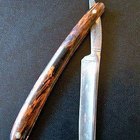
Wavebreakmedia Ltd/Wavebreak Media/Getty Images
Hair removal has been an integral part of grooming since prehistoric times. In fact, men used flint to remove unwanted hair as early as 30,000 B.C., according to the Hair Removal Forum. Although fashion trends have changed the style of removal as well as the area or areas on the body where hair removal commonly occurs, many of the same techniques used by the ancients are still in use today. Technological advances have made the process smoother, but some hair-removal tools have hardly changed since their invention.
Shaving
Razors made of flint made their debut around 30,000 B.C. By scraping the makeshift razors along their skin, cave dwellers were able to remove hair from their scalp and face, but vanity was not high on their list of reasons for doing so. Instead, hair removal helped control mites and lice infestations. Around 3,000 B.C., the first copper razors appeared in Egypt and India. From 1770 to 1880, great strides were made technologically in the razor industry. A barber, Jean-Jacques Perret, paved the way for the straight razor and safety razor, which debuted in 1880, with his book, “The Art of Learning to Shave Oneself.”
Plucking
The act of tweezing unwanted hair appeared in 500 B.C. and was popular among women. The tools varied according to what the women had on hand or what was available in the area. In Egypt, the Middle East and Asia, women used a twisted length of thread to grasp and tweeze hairs in a process known as threading. Threading still exists today.
Dissolving
The earliest depilatory creams contained harsh abrasives such as arsenic and quicklime, according to the Hair Removal Forum. The creams essentially buffed or burned off unwanted hair. Women continued to use homemade depilatory creams until the invention of the first commercially marketed depilatory cream, Nair, in the 1940s.
Waxing
Egyptian women paved the way for modern waxing. Around 60 B.C., they started removing hair via a process called sugaring. Sugaring, a hair-removal method similar to waxing, uses a homemade sugar solution to entangle and strip away hair. It is still used today as a natural alternative to wax. Waxing gained momentum in the United States when a New York City salon started offering Brazilian waxes, according to the Hair Removal Forum.
Considerations
Fashion has shaped the results and removal methods of shaving throughout history. In ancient cultures, the absence of body hair often indicated class. Only the lower classes let their hair grow. In the Middle Ages, women removed all of their hair, including the hair on their head, in the name of fashion. In 1915, a magazine ad prompted women to start shaving off their armpit hair in order to wear sleeveless styles, a practice that is still common today.
Related Articles

The Short Women's Haircuts of the 1940s

Substitutes for Wax Strips

Who Invented Hair Weaves?

Victorian Hairstyles for Men

Indian Beauty Tips for Removing Facial ...

Black Hairstyles of the 1800s

Chemical Curls for African Americans

When Was the First Hair Clipper ...

Why Did Women Cut Their Hair to Become ...

How to Stop Hair From Growing at the ...

The Significance of Earrings on Men

How to Get Rid of Body Hair Permanently

How to Remove the Blade on a Schick ...

The Tools Used for Curling Hair in the ...

Shaving Armpits the Correct Way

How to Wax Sideburns

Facial Hairstyles in the 1960s

How to Get Rid of Facial Hair on ...

How Does a Razor Work?

What Do Women Pirates Wear?
References
- Hair Removal Forum: Hair Removal History: From B.C. to IPL
- "Milady's Standard Textbook of Cosmetology"; Milady, Diane Carol Bailey and Margrit Attenburg; 2008
Writer Bio
Kathy Mayse began her writing career as a reporter for "The Jackson-County Times Journal" in 2001. She was promoted to assistant editor shortly after. Since 2005, she has been busy as a successful freelancer specializing in Web content. Mayse is a licensed cosmetologist with more than 17 years of salon experience; most of her writing projects reflect this experience.
Photo Credits
Wavebreakmedia Ltd/Wavebreak Media/Getty Images